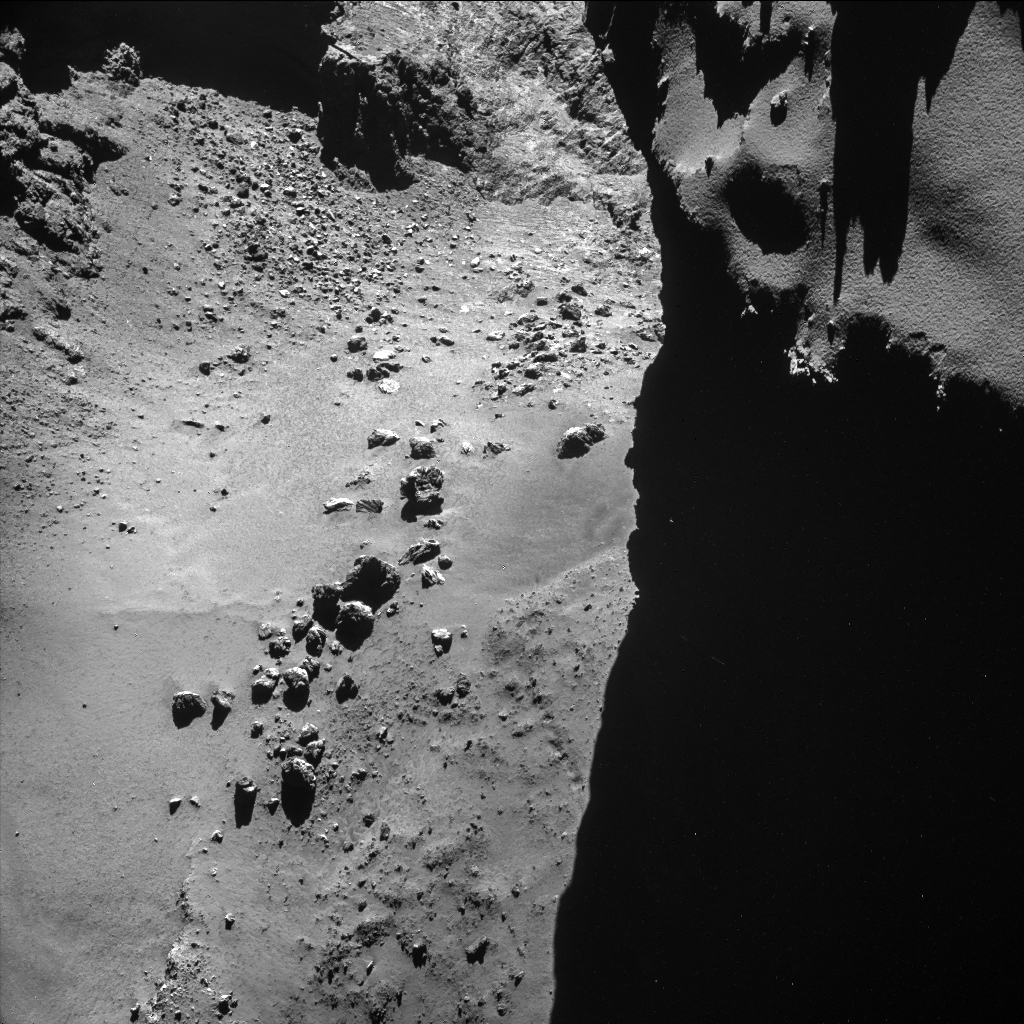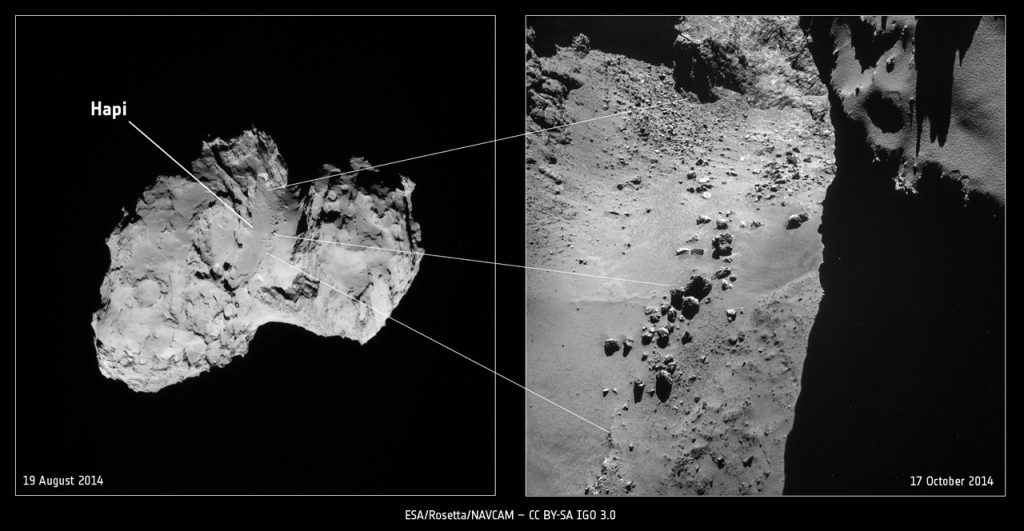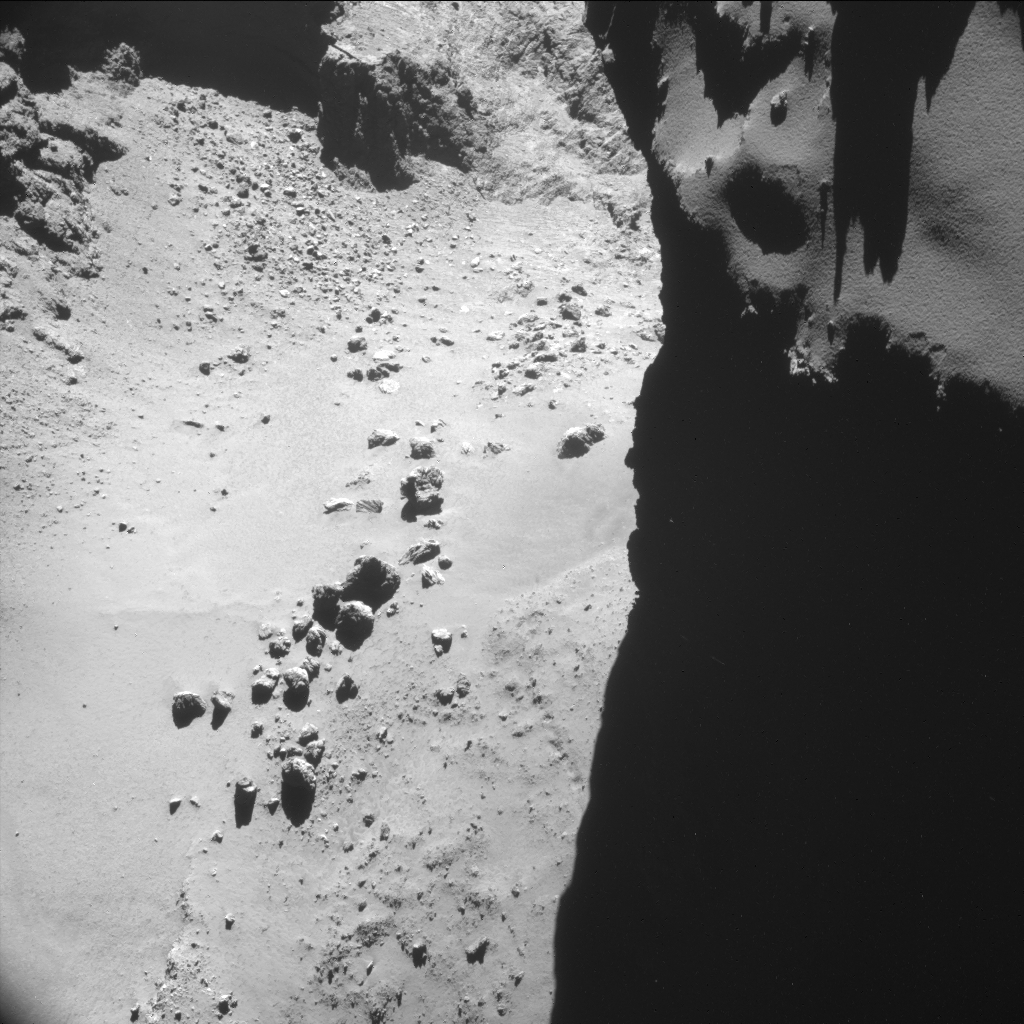With today’s CometWatch entry, we take a dip into the past, presenting a single frame NAVCAM image obtained on 17 October 2014, when Rosetta was in a bound orbit around Comet 67P/Churyumov-Gerasimenko. The image was taken from a distance of 10.0 km from the centre of the comet, and at that distance, the resolution of NAVCAM is 85 cm/pixel and the full field of view spans 870 metres.

The Hapi region on the ‘neck’ of Comet 67P/C-G, viewed by Rosetta’s navigation camera (NAVCAM) on 17 October 2014 from a distance of 10.0 km from the comet centre. The image has been processed in Lightroom to enhance the surface textures and to eliminate vignetting in the lower-left corner. Credits: ESA/Rosetta/NAVCAM – CC BY-SA IGO 3.0
The image offers a stunning view on the row of ‘boulders’ lying in the Hapi region on the comet’s neck. A small portion of the Ma’at region on the smaller ‘head’ lobe of the comet is visible in the top-right corner, casting a shadow down the lower right side.
As shown in this graphic featuring a full comet view taken by NAVCAM on 19 August 2014 from a distance of about 79 km from the centre, Hapi is a narrow region connecting the large and small lobes of the comet. The smooth appearance of Hapi suggests that it is likely covered in dust and other material that might have fallen from either of the two lobes, including the small and large boulders featured in detail in today’s CometWatch.
Hapi also appears to be the most active region on the comet’s surface so far, and last week’s colour image from OSIRIS shows this region to be somewhat bluer than the rest of the comet, suggestive of ice just below the surface. Observations with the VIRTIS imaging spectrometer should be able to confirm or contradict this hypothesis.
The original 1024 x 1024 pixel image is provided below:











Discussion: 27 comments
… So we are now eager to learn about the VIRTIS measurements.
“Observations with the VIRTIS imaging spectrometer should be able to confirm or contradict this hypothesis (ice just below the surface)”.
If VIRTIS indeed confirms the presence of sub-surface ice (which I hardly expect if only because such findings would clearly already have been immediately and widely disseminated…), there will then be even more need to account for the much *higher temperatures* already observed by VIRTIS precisely in this region. Sublimation of water-ice produces COOLING, not HEATING:
https://www.flickr.com/photos/130179313@N03/16524318826/
https://www.flickr.com/photos/130179313@N03/15927644524/in/photostream/
Data from other Rosetta instruments dedicated to local plasma composition and electromagnetic field analysis should confirm the alternative hypothesis that the “bluer” spectrum detected at the neck region has much more to do with the electric discharge activity manifest in the jets emanating from it than with any supposed sub-surface ice.
Once again I recommend to read this paper:
https://www.hou.usra.edu/meetings/lpsc2015/pdf/2156.pdf
“.. so far there is no evidence of thermal anomalies …”
“Detection of transient water ice…”
https://www.hou.usra.edu/meetings/lpsc2015/pdf/2021.pdf
“Since water production varies with time-of-day, the sublimating ice must be within the layer of the nucleus experiencing diurnal temperature variations. ”
https://www.hou.usra.edu/meetings/lpsc2015/pdf/2595.pdf
Just to mention some of the recent papers about water ice on 67P/C-G.
Thanks for the new links, Gerald 🙂
Forget electric discharge activity.
“The newly born pickup ions begin their trajectory parallel to the solar wind motional electric field, which is on the order of 0.5 V/km for an undisturbed solar wind at 3 AU. Therefore, most of the pickup ions in the vicinity of the comet (r<50 km) have energies below 30 eV."
https://www.hou.usra.edu/meetings/lpsc2015/pdf/2519.pdf
Thanks for the link Gerald. Another strange publication with just an introduction, no conclusions. And another example of playing with a speculative model based on unverified assumptions, along with the strange concept of pick up ions. “Picked up” by the solar wind but somehow retaining their low energy of 20 or 30 eV, when the solar wind is in the keV range. Detected as a separate low energy spectral band by the IES so what is their connection with the solar wind and what is the evidence of their origin.
As I suggested before no point wasting time with these models when you have the instrumentation there at the nucleus. The IES could be much better employed analysing the comet jets specifically. And try assuming for a moment that there may be sources of ions other than those resulting from photoionisation of water.
I’m sure the scientists like to investigate the jets, and the flight dynamics team is frightened by the idea.
You appear to completely misunderstand what ‘models’ are and how they are used in science in general.
Models are built on known physics, both the (so called ) ‘laws of physics’ and laboratory measurements of relevant parameters such as photoionisation and charge exchange cross sections etc etc.
We then build a mathematical model of the system, frequently making explicit approximations, which have to be justified. Sometimes, for simple systems, it can be an analytical model, more often it’s a computer solution to those equations using standard (but sometimes very complex) numerical methods.
Having got the result, you compare it to observation, and iterate. If it doesn’t agree, why? What approximation was violated? What the hysics did I omit? What input data might be wrong? How stable is the solution to small changes in the system (chaotic systems, beware.)
This process frequently leads to better understanding of what is actually going on.
Models are most certainly not a waste of time. Without them, you are looked no at isolated, the belated bit of data with no connection to the underlying physics. With no model, observations of species densities, magnetic fields, optical emissions, at differing locations are just separate numbers. With a model they form part of a consistent whole – and if it’s not consistent, that tells you you need a better model. If it is, it starts to suggest you understand it, and also often tells you what further measurements you should make to confirm that.
No need for the models lecture Harvey. We know what they are. You miss the point. No value in for example a speculative model based on the ice and sublimation assumption when we are there with the instruments easily capable of determining whether or not the nucleus is ice and whether or not the jets are sublimating gas.
The existing models have as the ionisation source both photoionisation & interaction with the solar wind, & the ‘down stream’ interactions of the species generated. Well supported from lab data re cross sections etc.
There is no other obvious source of other ions to model. The so called ‘discharge theories’ are entirely lacking in any coherent explanation of how these discharges work, even qualitatively, let alone quantitatively, so its impossible to model them. No one is going to model huge currents of unknown source for which no evidence exists.
Yes, we have lots of instruments, lots of prior measurements from spacecraft at other comets, & lots of earth based measurements. There is simple NO support for these incoherent ‘discharge explanations’ anywhere, none.
@ Harvey
“No one is going to model huge currents of unknown source for which no evidence exists”
67P has itself just provided the evidence for these “huge currents”, clearly visible in the form of ropes of dust jets bending at 90°, in the https://blogs.esa.int/rosetta/2015/03/20/cometwatch-14-march-6-hours-later/ thread.
Their source is “unknown” to the defenders of the standard theory, but not to EU proponents (see my comment: https://blogs.esa.int/rosetta/2015/03/20/cometwatch-14-march-6-hours-later/#comment-413304).
Now we have the evidence, perhaps it’s time, at last, to start modelling them.
Thomas. You mistake a vague percieved similarity to a ‘discharge’, for *evidence*. In fact, having worked with & around a HUGE variety of dischares for twenty odd years, it does not look like one to me.
But not only do we have no evidence for, & a lot against, we have no conherent description of how this putative discharge works to try & set up a model. You need to start with a viable ‘Physics 101’ version; so please answer the question already posed:
“We are told the comet is ‘negatively charged’ and the jets are ‘discharges’; electrons move away from the comet, ions *to* it. That means there is a current flow in the discharge; nobody gives a value. Well, to move just *one mol/sec* as ions – 18g/sec for water – needs a current of just under 10kA. Comets are known to degas *FAR* more than that, factors of thousands, hundreds of thousands more. Discharges are very inefficient at accelerating neutrals (electron/molecule mass difference) so that doesn’t work well. At the very least we need to provide the sublimation energy, around 40-50kW needed for 1 mol/sec of water depending on whether its ice or liquid – so 10kA at a few volts. Just relying on ‘intuition’ (dangerous) these are huge scale ‘discharges’, they move tons of material, the current is going to be pretty big. We routinely run 100’s of kA pulsed discharges, 100A CW discharges, in labs, in welding workshops.
So, maybe the comet is a charged capacitor. Let’s not worry yet about how it got charged, gets recharged for the next orbit. It has a capacitance, if we make it a 5km sphere (overestimate) of 0.28uF. Let’s charge it to a MV – yes, a megavolt; I think we’d have noticed that by now, but whatever. The charge is 0.28C. Just ONE AMP will discharge that in 0.28 *seconds*. Desperation, how about a GV, a gigavolt; you get 280 seconds; five minutes, then the lights go out.
Oops. So, something is *supplying* the charge, just like a real CW discharge. The electron leaves the surface of the conducting electrode and its replaced by the wire connected to the power supply whose other end goes to the anode; a circuit. So, somewhere else on 67P, where is the supply of electrons arriving? Why don’t I see some distinctively different region, certainly dissipating power? Where do they come from, what provides the power & the charge? (No, just saying ‘the sun’ will NOT do.) Why do they flow *to* 67P here by some mechanism, when very nearby they flow *away* from 67P? It needs to be a conducting body to get the charge from the ‘arrival point’ to the ‘departure point’, so how can the electric field apparently point in opposite directions onto the same conducting body with no nearby ‘electrode’? (Oh, & rock, ice & polymeric organics don’t conduct too well.)
And of course for these huge currents, why don’t we see the magnetic field, why did Rosetta specifically report a plasma consistent with photionisation of degassing H2O (as other spacecraft have) & not this huge plasma injection, why are there no reports of appropriate optical emission, why does it stay transversely uniform unlike most discharges, why are the no ‘cathode dark spaces’ etc visible axially. In other words, why doesn’t it actually look like & behave like a real discharge if it is one? The supposed visual comparison is simplistic in the extreme.
At the most basic, simple, physics 101 level, it does not begin to make sense.”
BTW, one point I’ve made before I should restate.
I do NOT rule out minor roles for discharge phenomena on 67P. One can imagine credible scenarios from, say, triboelectric effects in the moving dust layer, some sort of photoemission effects, at greater distance maybe, differential low level charging of the surface by the solar wind. It would *not* surprise me to see, say, a local ‘lightening strike’ on 67P (though it would be interesting.)
My utter disbelief applies to large scale effects responsible for major errosive processes; not to such so far unobserved,but might be possible, small scale scenarios.
The source for electrons is photoionization, if you are looking for electric charging:
“The forbidden O I λ1356 multiplet is indicative of excitation due to electron impact by electrons produced by the photoionization of H2O”
https://www.hou.usra.edu/meetings/lpsc2015/pdf/2189.pdf
and I wonder what’s next?
Amazing
Great image Claudia. The difference in the appearance of the surface dust layer in Hapi compared to the Ma’at region on top of the head lobe. is very striking here. In Hapi the surface, although it contains some areas of small shallow horseshoe shaped depressions, it is largely quite smooth. The Ma’at region however the surface dust layer is completely uneven with ridges, hollows, depressions of all shapes as well as the ubiquitous horseshoe shaped ones. A sign that the Hapi valley surface layer is regularly recoated in very fine dust. Yet towards the top of the image the dust layer is almost gone, and several small patches of subsurface exposed.
A very odd looking structure can be seen in the mouth of the cave at the top left of the image. Almost “treelike” with protrusions and surfaces at all sorts of odd angles. It looks like some sort of crystalline growth, though how it could form as such I have no idea. The field of rubble in front of the cave gives the impression that it has been deposited by some sort of flow, a flow that also seems to have carved through the side wall of the valley.
Finally the row of pits at the right of the image that were vaguely visible in very early images can be seen nicely here. Its still not clear if there is an underlying fault or crack responsible, or a seem of material of different composition that has eroded more rapidly. The mechanism for forming these semi-circular horseshoe depressions would be fascinating to know, since it seems responsible for so many of the surface features from centimetre scale up to tens of metres. We see them close up in the ROLIS images at Agilkia. Sublimation would seem the obvious cause, but why this repeating shape at all scales? They are even visible on the tiny dust grains collected in the coma. Has any experimental work been done that replicates them I wonder?
In my opinion the treelike thing is an illusion .
Just a rock half in light half in shadow .
At LPSC, Ian Wright (ptolemy experiment) conjectures that the polymer hydrocarbon found by Philae is polyoxymethylene:
https://www.newscientist.com/article/dn27173-rosettawatch-new-clues-about-the-origin-of-comet-67p.html
Boulder with void inclusions of 3m-21m at pixel 424,483 of
https://www.esa.int/var/esa/storage/images/esa_multimedia/images/2015/03/comet_on_17_october_2014_-_navcam/15310981-1-eng-GB/Comet_on_17_October_2014_-_NavCam.jpg
ERRATA: Should say: “…void inclusions of .8m-5m…”
Hi Robin. “…Almost “treelike” with protrusions and surfaces at all sorts of odd angles. It looks like some sort of crystalline growth.”
Only 3 angles visible, an formed from a few more planar ‘cardboards’. Indeed crystalline by growth or a former crystal container ‘ceramic mold’ looks to me too.
CF could be right of course, just an odd shaped feature combined with particular lighting. It just looks a bit too complex for that. Differential erosion due to a non homogenous composition could explain it too I suppose. It just looks an odd shape, its significance I’ll leave for others to ruminate over.
Want to point a certain ‘rhombus-ity’ to surface layering in this particular shot. One parallel family coming directly to the viewer, and another going from top left to bottom right.
Think this is plausible in ‘energy flow’ layering.
At
https://www.esa.int/var/esa/storage/images/esa_multimedia/images/2014/08/comet_on_7_august_a/14721226-1-eng-GB/Comet_on_7_August_a.jpg
Main layering at 2 o’clock angle, pointing to crater at top right.
Also layering at half to 12 o’clock angle, presuming pointing to crater on top of head.
The nature of the energy flow creating this layering could be seismic [by impacting]. This kind of scars could occur only at young age. When porosity low and Icy-ty high.
Two vectors of layering creating ‘ducts’. Three vectors of layering creating ‘cells’.
Erosive ‘concave’ facets like the ‘cliff’ and that one at foreground of
https://www.esa.int/spaceinimages/Images/2015/03/Comet_on_9_March_2015_NavCam
could actually be following one or more impact ‘layering vectors’